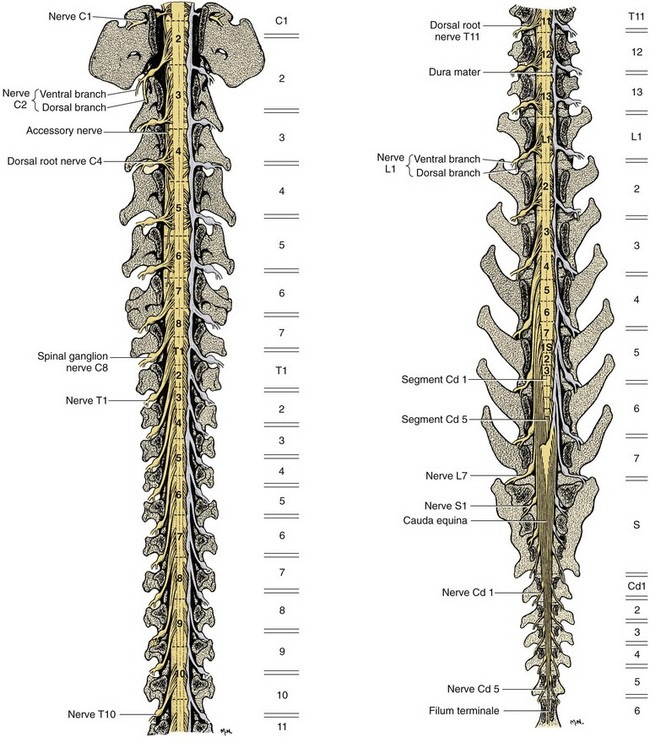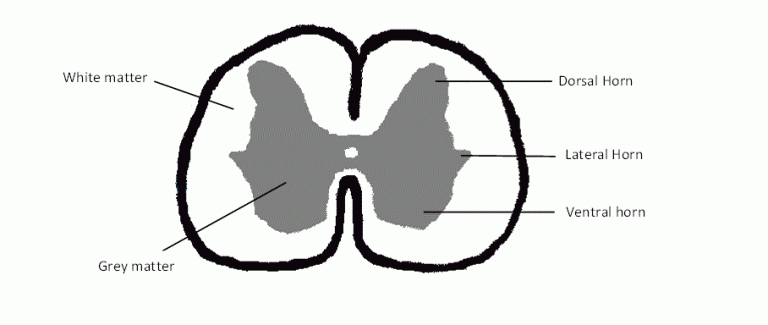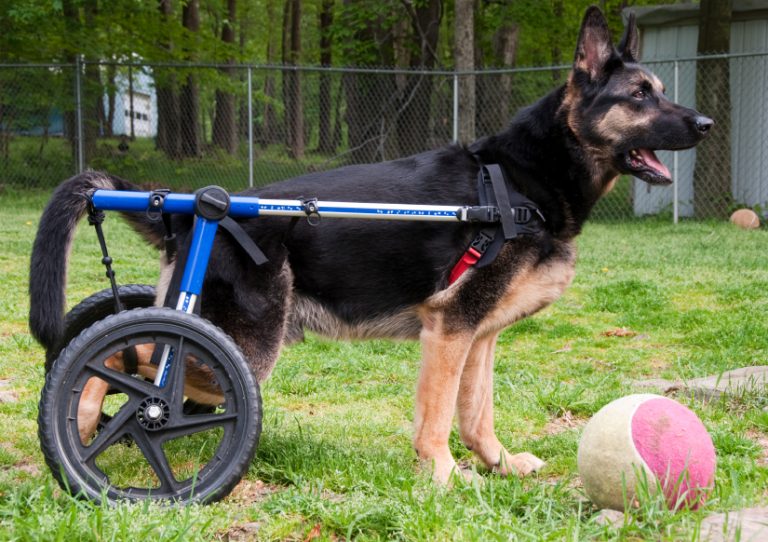On this – the 3rd anniversary of CriticalCareDVM.com – I wanted to devote some time to an important and under-appreciated cause of pelvic limb weakness and paralysis in dogs. Most pet parents know about intervertebral disc disease that can cause neurological complications like difficulty walking and spinal discomfort. Yet, degenerative myelopathy should be considered in our older canine companions with pelvic limb weakness and incoordination. To raise awareness, please enjoy this week’s post. Happy reading!
Degenerative Myelopathy – What is it?
Degenerative myelopathy is a progressive disease of the spinal cord that affects older dogs. To understand this disease, one must first know a little bit about spinal cord anatomy. The spinal cord is cylinder-shaped structure of nervous tissue. It’s divided into multiple segments. In dogs, there are cervical (8), thoracic (13), lumbar (7), sacral (3), and caudal (5) segments. From each segment, spinal or nerve roots emerge to travel to various tissues throughout the body as nerves. The entire spinal cord, including the roots, is surrounded by a protective layer called the meninges and ultimately encased within the vertebral canal.

The spinal cord is composed of grey matter and white matter. The former contains synapses, the connections between the various cells of the nervous system. The latter is composed of axons, the fibers that connect different parts of the grey matter to each other.

Patients with degenerative myelopathy progressively lose the white matter in their spinal cord. When this happens, the connections between the brain and pelvic limbs don’t work properly. The degeneration begins in the thoracic segments of the spinal cord, and is characterized by:
- Demyelination – loss of the insulating structure around axons
- Axonal loss – actual loss of nerve fibers that transmit messages

Degenerative Myelopathy – What does it look like?
Patients with degenerative myelopathy are older, typically 8-14 years of age. The initial clinical signs are quite subtle like intermittent scuffing of the back feet. Close examination of nails on the hind paws of affected dogs may identify an abnormal wear pattern. Only one limb may be initially affected, but both pelvic limbs will ultimately be involved. As the degeneration progresses, affected dogs may drag their feet, be uncoordinated while walking (called ataxia), and may have difficulty rising in the pelvic limbs (called pelvic limb paresis). Some dogs will develop urinary and fecal incontinence. Ultimately, dogs with degenerative myelopathy become paralyzed in their hind legs. Degenerative myelopathy is not painful, and progression to paralysis typically takes 6-12 months.
Degenerative Myelopathy – How is it diagnosed?
Research by board-certified veterinary neurologists have identified a gene that when mutated confers an increased risk of developing degenerative myelopathy. Dogs can be screened for this genetic mutation. There are three possible test results:
- Normal – these dogs have two normal / un-mutated genes
- Carrier – these dogs have one normal gene and one mutated one
- Affected / At risk – these dogs have two mutated copies of the gene
The frequency of this genetic mutation is >40% in close to a dozen breeds, and more than 70% in Boxers, Wire Fox terriers, and Pembroke Welsh corgis. Normal and carrier dogs are very unlikely to develop degenerative myelopathy. Unfortunately, affected / at risk dogs are quite likely to develop clinical signs as they age.
Traditionally, examination of the spinal cord after death has been considered is the gold standard way of definitively diagnosing degenerative myelopathy in dogs. Other diseases may mimic the clinical signs of degenerative myelopathy. Therefore, it is essential to rule out those disease processes appropriately, including:
- Intervertebral disease
- Spinal cord tumors
- Spinal cord trauma
- Nervous system infections (bacterial, protozoal, fungal, parasitic)
- Stroke
Degenerative Myelopathy – A Diagnostic Breakthrough?
Ruling out other disease processes requires advanced (and expensive) diagnostic procedures like magnetic resonance imaging (MRI). As such, veterinarians have been searching for a better, more cost-effective way to definitively diagnose degenerative myelopathy. Board-certified veterinary neurologists and researchers at the University of Missouri and the Broad Institute at MIT/Harvard previously documented a genetic link between degenerative myelopathy in dogs and amyotrophic lateral sclerosis (ALS; Lou Gehrig’s disease) in people. On 4 May 2017, news broke of a potential breakthrough in diagnostic testing for degenerative myelopathy. One of the biomarkers used to diagnose ALS appears to be helpful for detecting this debilitating condition!
Phosphorylated neurofilament heavy proteins (pNF-H) are released in cerebrospinal fluid (CSF) and blood in humans with ALS because of the degeneration of spinal tissues. Researchers found pNF-H levels were increased in the CSF of dogs with degenerative myelopathy compared to normal dogs and those with mimicking non-degenerative spinal cord conditions. There is an ongoing clinical trial underway at the University of Missouri, and I’m excited to see what the final findings will be! If you believe your dog may be living with degenerative myelopathy, I would strongly encourage you to partner with a board-certified veterinary neurologist as soon as possible to fully explore your diagnostic options.
Degenerative Myelopathy – How is it treated?
To date, there are no specific therapies known to prevent or even slow down degenerative myelopathy in dogs. Rehabilitation therapy, including acupuncture and hydrotherapy, may be helpful. The use of various assistive equipment can be successfully employed to prolong quality of life.

Meticulous care must be given to an affected dog’s environment. Comfortable bedding must be used to prevent bed sores. Dogs should be kept clean so urine scalding and skin ulcerations don’t develop. Pets should maintain an ideal body weight, as recumbent overweight and obese dogs are more prone to issues like bed sores and respiratory complications. Pet parents are encouraged to partner with a board-certified sports medicine and rehabilitation specialist and/or a certified canine rehabilitation therapist to develop the most appropriate rehabilitation program for their affected canine companion.
The take-away message about degenerative myelopathy in dogs…
Degenerative myelopathy is a progressive degenerative condition of the spinal. Older dogs are affected, and ultimately develop paralysis. Definitively diagnosing this condition is challenging, but new research shows promise. Although there is no current prevention or effective treatment, rehabilitation can prolong quality of life.
To find a board-certified veterinary neurologist, please visit the American College of Veterinary Internal Medicine.
To find a board-certified veterinary sports medicine and rehabilitation specialist, please visit the American College of Veterinary Sports Medicine and Rehabilitation.
To find a certified canine rehabilitation therapist, please visit the Canine Rehabilitation Institute.
Wishing you wet-nosed kisses,
cgb





